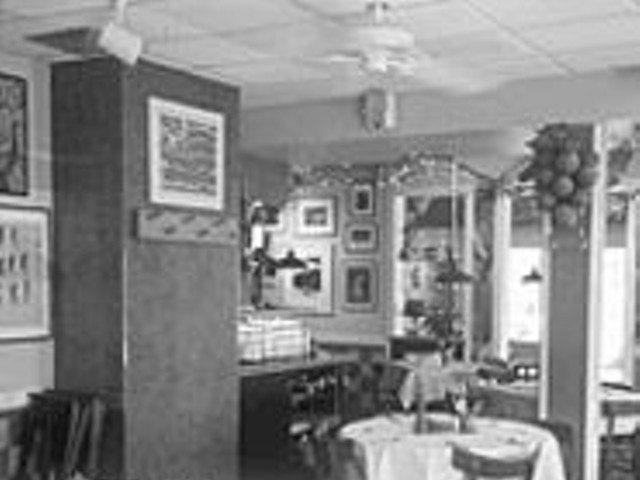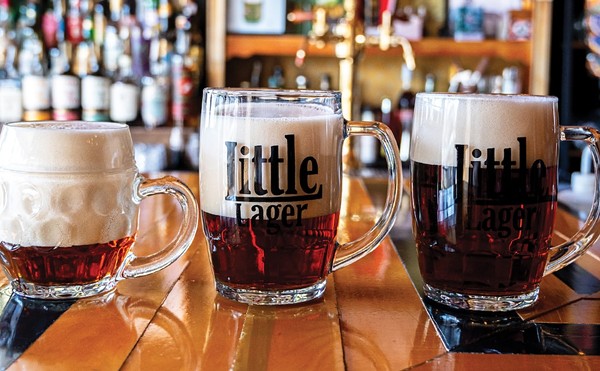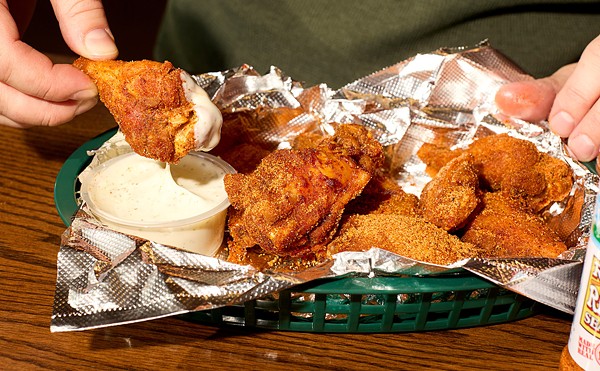The tapas craze swept the rest of the country more than a decade ago, with places such as Chicago's Café Ba-Ba-Reeba! and Emilio's now having made the jump from trendy upstarts to established veterans on that city's restaurant scene. Meanwhile, St. Louis has certainly had its share of "tapas-like" approaches that allow diners to order multiple small portions in place of the traditional appetizer-entrée succession.
And there are and have been a few spots offering exclusively Spanish recipes -- as opposed to a general "Mediterranean" focus, or even just reducing the size of any old recipe and calling it tapas. The hybridized Guido's -- run in the traditionally Italian neighborhood of the Hill by a Spanish-heritage family and therefore featuring pizza and pasta as well as tapas -- has been serving authentic-recipe tapas for several months. Previously, La Mancha was a small family-run Spanish place near the Bevo Mill and Tango Grill was a much larger and more elaborate endeavor in the space that ultimately became Turvey's on the Green. Both of these, however, were short-lived enterprises.
Now, however -- also on the Hill, right down the street from Guido's -- about a half-million dollars has gone into creating a full-blown Spanish experience called Modesto, located in the recently retrofitted and rehabbed Fair Mercantile building, which for many years housed a furniture retailer. It's brash, it's fairly loud and it's very Spanish, with even all the wines and cheeses claiming exclusively Spanish origins.
The key figures behind Modesto are W. Brendan Marsden and Julie Block out front and Aaron Ingrassia in the kitchen. Marsden is a St. Louis native with kinship to the legendary Brennan restaurant family in New Orleans who tried to be a business techie before leaning on his St. Louis and New Orleans food experience to open a restaurant of his own; Block's background is in retail, which probably explains the bold environment at Modesto. Ingrassia came to St. Louis from Santa Barbara to sous at Eau before mutual contacts put him and Marsden together to dream up a new concept to fill the void in local Spanish dining options.
Actually, "bold" is probably a bit too timid a word to describe the design at Modesto, provided by the architectural firm Tao & Lee Associates, also known for the distinctive look of the Crazy Bowls and Wraps chain. Walls, some curved, are orange and oranger, banquettes are yellow and red, and a display kitchen across the back of the main dining room is swathed in bright-red tile. Exterior walls are exposed brick with huge windows, and decorative elements include stainless-steel sculptures, a series of Spanish scenes painted in a form like oversized glazed tiles and unusually well-hung light fixtures that one can only guess are intended as a tribute to the legendary romantic prowess of Latin men.
As for the food, once again, that word "bold" is appropriate but maybe even a little understated. The flavorings and flavor combinations in both the tapas and the entrées are powerful, sometimes unusual and almost always successful. One example that comes to mind immediately is the jamón y melon, cantaloupe draped with paper-thin serrano ham, densely textured and flavored, similar to the world-famous prosciutto you can get from Volpi's, just a block away. A drizzling of peach balsamic vinegar added a mellow tartness to the sweetness of the melon and the saltiness of the ham.
We constructed an entire meal for four of tapas, lounging our way through gambas al Modesto, an update on a classic tapa, gambas al ajillo -- shrimp with garlic -- to which Ingrassia added orange zest and coriander; patatas alioli, a cold potato salad with olive, celery, onions and copious garlic; buñuelos de bacalao, silver-dollar-sized cod cakes with saffron aioli; langosta frita, a deep-fried small lobster tail; pinchos morunos, skewers of chewy lamb, not too closely trimmed so that the fat could shamelessly add an extra element of juiciness and flavor; queso de cabra y champiñones al horno, a spicy tomato, mushroom and goat-cheese dip for long ovals of toasted bread; brochetas de solomillo, kebabs of beef with crumbles of Idiazábal cheese; and salpicon de mariscos, a seafood cocktail of squid, shrimp, monkfish and lump crab.
The only one of these I didn't totally enjoy was the seafood cocktail, one of whose ingredients left a bit of fishy aftertaste. With the rest, however, each bite generally brought a burst of concentrated flavor -- dense, timeless olive; fresh herbs; chile fire; and lots and lots of garlic.
The final round of tapas was, unintentionally, the fruitiest, including in addition to the ham and melon a sampler plate of Mahon from the cow, Manchego and Idiazábal from the sheep and "drunken goat" cheese, the final so named because the rounds are soaked in red wine. A simple plate of these cheeses would have been fabulous by itself, but this one was enhanced by a tantalizing selection of dried fruits, including cherries, raisins, strawberries, apricots and a pear, as well as a small cluster of fresh grapes.
Going the entrée route is relatively pricey, with many above $20, although you can get in under this with either a paella Valenciana or a vegetarian paella called huertana de Murcia, both of which must be ordered for at least two people. We went with two of the more elaborate entrées, a fish stew called zarzuela de mariscos and the Spanish translation, by means of cabrales cheese, of a beef fillet with Roquefort (in French) or Gorgonzola (in Italian). This filete de solomillo, as it was called, again mixed any number of distinctive flavors, punctuating a potato cake with coriander, putting it and the 8-ounce fillet in a port-wine reduction dotted with five whole figs (which, although roasted, were quite subtle in flavor). The fish stew included half-a-dozen mussels, four clams, three shrimp, half of a lobster tail and numerous chunks of monkfish that, when simmered with the lobster, really did end up simulating its texture and flavor, and the liquid -- cinnamon-scented saffron broth with a hint of almonds -- provided an ethereal perfume that wafted up like a warm sea breeze on an exotic island.
And dessert? Even here, Ingrassia is in your face, putting ancho chile in the chocolate mousse (be sure to rent Chocolat either before or after trying this) and serrano chile in a pure, powerful strawberry consomme, topped with fresh berries, in fuego y hielo, "fire and ice." (In fairness, there are also some excellent and more mundane dishes, such as crema de Pedro Ximénez, a zabliagone-like custard made with sherry, and Manchego y membrillo, thin wedges of cheese topped with a quince jam.)
Our service was ragged for the tapas meal, with the all-black-attired staff too overeager to clear plates but not ensuring that we had enough clean plates to eat from, but it picked up nicely when we ate the full meal, and in both cases the staff had obviously been given thorough training on the intricacies of this new (to most St. Louisans) style of cuisine. And given that St. Louis was actually Spanish territory before it was French, it's about time Spain was better represented on the local restaurant scene. Modesto has more than a modest chance of being around for a long time to come.





